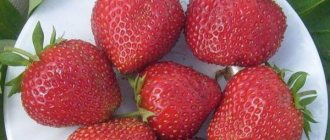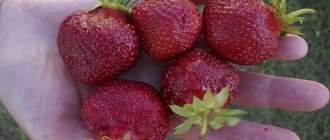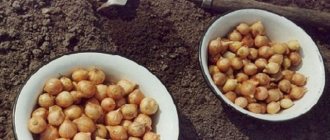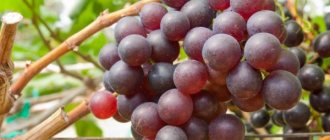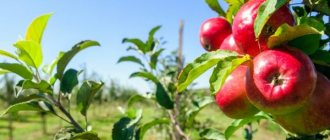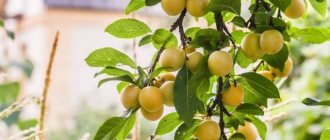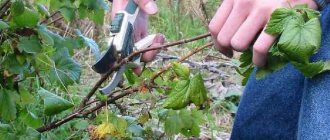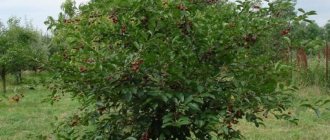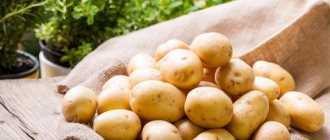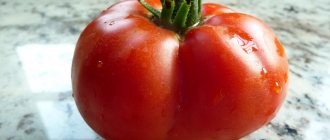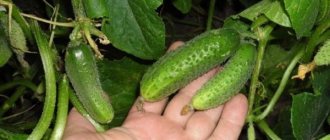Description, characteristics of the variety
The Carmen variety, obtained as a result of selective crossing, is not demanding on the composition of the soil and is able to tolerate low temperatures and lack of moisture without consequences. An adult plant with bright green foliage takes the form of a large bush with two-meter shoots, along the entire length of which fruits form and ripen.
The high yield is due to the self-pollinating nature of the hybrid. Bisexual flowers bloom in May, and the fruits ripen in August. The variety forms large clusters weighing up to 2 kilograms with a wide base at the point of attachment to the stem and tapering towards the end.
Expert opinion
Zarechny Maxim Valerievich
Agronomist with 12 years of experience. Our best country expert.
Ask a Question
Carmen is a large-fruited variety with oval, elongated berries from reddish-lilac to deep purple. Thin-skinned fruits with elastic, juicy pulp have a sweet taste. The average sugar content is 20% with an acidity not exceeding 8 grams/liter.
Characteristics of Carmen grapes:
| Parameter | Description |
| Purpose of grapes | Dining room |
| Average bunch weight | 0.6-1.0 kilograms |
| Berry size | up to 3.6 centimeters in length |
| Berry weight | 8-12 grams |
| Average bush yield | 6 kilograms |
| Fruit ripening period | 100-110 days |
| Limit of the lower limit of temperature resistance of a plant | -25 °C |
Cuttings with good rooting ability grow quickly. The unpretentiousness of the plant and the quality of the berries, which ripen relatively early, set the variety apart from its competitors.
Useful properties of berries
This variety is useful for people who have blood diseases. Taking Carmenere can improve:
- condition of blood vessels, heart;
- general condition of the body.
It also promotes the production of collagen and elastin in the tissue area, which allows you to rejuvenate the body.
Tasting assessment
High-quality Carménère wine is produced from the variety of the same name, which grows in the most fertile lands of Chile. Recipes and other tasting characteristics of products may vary based on the personal preferences of manufacturers.
The visual appearance of the wine is red with different shades. The bouquet is presented with bright fruity notes, often enriched with tones of herbs and spices. The taste of the wine is expressed by the color of delicate undertones of ripe grapes.
Due to the high tannin content, wines have bright flavors:
- black currant;
- plums;
- figs;
- prunes
See also
Description and subtleties of growing Timur grapes
Read
You can also smell black and white pepper, anise, vanilla, cinnamon, and licorice in the aroma. Vegetables: green bell peppers, herbs, lavender, olives.
Mineral aromas include:
- smoked meats;
- wet ground;
- skin;
- tobacco;
- coffee.
Calorie content
Carmenère is a high-calorie product: per 100 g. 67 kcal. Due to the increased calorie content, the introduction into the diet is moderate.
Children under 6 years old are not given grapes.
Since the calorie content is high, the variety is often used to make rose and red wine. Also used to make raisins, which are used in baked goods and confectionery.
Acidity
The acidity index of the bush is 6-8 g. per liter The berries contain a high concentration of sugar - about 23%. It all depends on the region where the variety is grown, how the plant is watered and fertilized.
If the growing conditions of the grape bush are suitable, then the taste of the variety improves, a berry and chocolate taste and a rich aroma develop.
Landing Features
Grapes are propagated by cuttings, layering and rootstock. Viable seedlings take root quickly. The optimal season for planting is spring, when the average daily air temperature does not fall below +10 °C.
For the vineyard, choose a sunny area, preferably on the south, southwest side.
The planting site is prepared in the fall by digging up the soil with the addition of complex fertilizer or humus. The plant is undemanding to the soil, but areas with stagnant groundwater should be avoided or their level should be adjusted by forming an embankment.
In the spring, dig a planting hole with a diameter of 0.5-0.6 meters and a depth of 0.7 meters. A layer of manure is placed at the bottom of the depression, which is covered with a layer of soil. The seedling is placed in the prepared hole so that the root collar is visible above the surface. Sprinkle the plant with soil, tamp it down and water it.
Where to plant
The answer to the question of where the Carménère grape variety grows is, of course, Chile. This variety is also often grown in the USA. In any case, a distinctive feature of the Carménère grape, in addition to its poor resistance to cold, is that it does not tolerate wind very well. Therefore, this variety should be planted on hillocks on the leeward side or behind the walls of buildings.
Carménère grapes like soil that is well-drained and nutritious. It grows very poorly in wetlands. In Chile, this grape is often planted on rocky soils. It is believed that wines made from the berries of Carménère grown in such areas are of higher quality.
Further care of the crop
Growing a variety on the site will not require much time and effort from the owner. Post-planting care for Carmen grapes includes:
- removal of weeds;
- loosening the soil around the bushes;
- watering;
- feeding;
- vine pruning;
- fight against infections.
Watering is done as the soil dries out. During the dry period - once every 405 days. Water the bushes before the fruits begin to ripen. Then watering is stopped, but the need to loosen the soil remains.
Fertilizing is carried out twice a year. In the fall, organic matter is applied under the bushes, and in the spring, mineral fertilizers rich in potassium and phosphorus are applied. Trim the vine in early spring, before sap begins to flow, leaving no more than 8 buds.
To avoid diseases affecting grapes, in the spring, before flowering, preventive treatment of plantings against infections and pests is carried out.
A little history
Initially, these grapes began to be grown in France.
Carménère was once very widespread in this country. Actually, wine was not made from it in France. However, the berries of this variety were often used for blending here. Moreover, the percentage of Carmenere content in such wines usually did not exceed 4%. In 1867, in France and throughout Europe, this variety was completely destroyed by phyllopsera and was considered lost for a long time. But in 1994, the French ampelographer Michel Boursicot accidentally discovered this grape in Chile. Until that time, the farmers of this country did not even suspect that it was Carménère that they grew. They called the grapes they cultivated Chilean Merlot.
It was later suggested that the Carménère grape variety was cultivated in the 19th century. farmers in Chile began by mistake. Apparently, the workers who packed the seedlings for shipment to America once simply mixed up the names of the varieties. Carménère arrived in Chile as Merlot.
Currently, this variety is grown everywhere in this country and is used to make mainly young wines with a slightly herbaceous flavor. In Europe, such grapes are practically not cultivated.
Diseases and pests
Carmen grapes are susceptible to some fungal and viral infections and are attractive to insect pests. Provoking factors for infection are:
- high humidity;
- hot weather;
- lack of nutrition and mineral components;
- moisture stagnation;
- no loosening of the soil.
See also
How to combat powdery mildew (oidium) on grapes using folk and chemical means, what is the best treatmentRead
To avoid crop loss, it is necessary to carry out timely preventive treatment of bushes and provide the plants with proper care.
Signs of infection and ways to combat common grape diseases:
| Disease | Signs | Control measures |
| Mildew | Whitish spots on the outside of the leaf blade, fine-grained light coating on the inside of the leaf. Over time, the lesions become necrotic, and the infection spreads to the inflorescences, which eventually die. | 1. Removing affected leaves. 2. Fungicidal treatment. 3. Mulching the soil. 4. Application of mineral fertilizers. |
| Oidium | Slowdown in the rate of vegetative growth, leaf curl, the appearance of a whitish coating on leaves, shoots, and inflorescences. At an early stage, the fruits dry out, at a late stage they rot and crack. Rotting is accompanied by the smell of rotten fish. | 1. Treatment with fungicides. 2. Providing air access to the bushes by tying and pruning. 3. Loosening the soil. |
| Anthracnose | Brown spots with a white border appear on the leaves. The affected areas darken and deteriorate over time. Shoots and inflorescences darken and die. | 1. Removal and destruction of clearly affected parts of the bush. 2. Fungicidal treatment. |
| Phylloxera | Grape aphids attack leaves or roots. Root phylloxera destroys roots and trunks, while leaf phylloxera infects leaves, shoots, and inflorescences. | 1. Destruction of affected bushes. 2. Insecticidal treatment. |
The best ways to protect against vineyard diseases remain preventative treatment of plants, rational watering, regular loosening of the soil and application of fertilizers. Fungicides and insecticides are best used in advance, in the spring, before flowering and fruiting.
Forum statistics
208683 Messages in 1636 Topics from 5641 Users. Last user: Cerberus Last message: “Khanka is a raisin table…” ( Today at 01:29:28) Latest messages on the forum.
Now on the forum
32 Guests, 4 Users
Users in the last 15 minutes: leonidych, vlad51, Natasha, Victor B [Blocked] [Section moderator] [Forum moderator]
Maximum online today: 112 . All-time maximum online: 2758 (28 July 2021, 17:22:51)
Users who visited the forum in the last 24 hours
Total: 317
(Visible: 316, Hidden: 1) 1963, leonidych, vlad51, Natasha, Victor B, Nikolai Lipunov, Nikolai Mikhailovich, sergei, Evgeniy52, 77volt, hanter64, Tatyana B, kosmos, slavalimon, Alexander Vl., Mikhail77, skier, rivaN , y_fed, Kazak, Igor Sergeevich, Victor55, Andrey15, OlgaOs, Ilya 77, DorontsovPeter, Chapai, Buba, Mikhno Alexander, Alexander K, dralexk1, alexsandr, Amber7394, SANYCH, Pioneer, DimaRostov, Dmitry 77, Verona, DED2, MaxL, nicson7, Vasily V., Kenig, Alexander Taganrog, VitalySD, Dmitry-Kozadoev, Realist, Alexey Deminov, Elektronik_t, Galinka, Skif, DSW, Alexey Agryzkov, Taker, Kadyrov, bonami, antar, Sergey 1965, Andrey Gladilin, SvetlanaBondareva, tolya , Nadezhda Grig, Naumov Igor, Igor F., kvg, Pavel 64, Volgar, Capricorn, Roman Fedorovich, igor222, max2008-01, Iv Iv, Vika, Andrey Lis, Evgeniy30, lomakin1969, linalenadavi, gheo55, Sergey Chistokletov, mystic69, Grinya, Cherkessk, Andrey76, DIL, Serzh1978, Haus, , Vladimir-kanevskaya, Iglika, Marina Protasova, Mikhail Alekseevich, Andrey 31, Linx, Morgana, Igor K, Tatyana Rogacheva, Polyanina Ekaterina, Yuri _Saransk, Sergey 61, Armagnac, Alexander48 , tsv, Verbitsky E.I., Lyudmila, Victoria Aleksandrovna, Vladimir Berdnikov, vladimirM, and.drew, Maximilian, Denisovich, Soshnin Yura, Tikhy, Elena Z, Sasha57, Natalia Nikolaevna, Gaivoronsky Yuri, Oleg56, weather forecaster, ElenkaF, Lydia58 , Vyacheslav03, Sa-shura, irahelm, Pitko, Volodya R, Volgogradka, Alexander71, Natalia1968, Valentina Ivanovna, freesia, L.A.P., Lyuda5, Alexey V, dayton, marlin64, Tanyusha, Vasily1111, Yuri 14, Vova Kapran , Dmitry Nikolaevich, Oleg Filippov, Valery Rastorguev, Kalevanych, AlexsandrP, LeXa_KoT, Sergey Yuryev, Inna161, cfibr, stenlly2010, rambo, maxbul, Nadymchanka, Ivan Levin, Eduard., nik2, serginio, potap05, nadia, VeraNiK, Sergey Tashchiyan, G.V., Gardener - amateur, Alexander-ask-34, Vladimir Kostochkin, Wintel, Vyacheslav Vladimirovich, mers, Izhitsa, Ramiz, Akhmed, gardener, P7N, alexss, Zaur, TITOVA LYUBOV, Sergey Ko, Tatyana Volzh, Grandfather Young, pioneer-2, ketch, Bublichenko Alexander M, Ildar, Sergei Vasilevi4, Oleg Ivanovich delivered, Helga, Marshal, Vasily 53, Den, Alexander150, Yavgen3678, vikbublik, Valerie, Henry, Alexander_89, nick041, Svetlana Streletskaya, Antrikan, neposny, yak , 25nata35, Vladimir Buturlakin, Yagodka, Aprel, Antonk1983, PS-URA, spotlight, Nikolay S., Andrey68, Alexander565, Gennady163, AndSanych, Alexander Gay, Alex65, kdm57, oleg9f, zsb, Svetlana Korotina, Dmitry Badaev, Belgorodets, Yura , formula1, Cerberus, 64nikolay64, Yuri Semyonov, YurSanych, Kryn, N.A. Sokolov, TIS, Guram, sem_en, Alexander Smirnov, AlexanderD, Spikina Galina, Anatoly Sivkov, Snezhinets, Alexey Sh., mira567, Mst, victor_, Vadim , Salex, Yuri P., Bison, thanatos, Alexander Sh, Vardan, cecet71, Coltrane, Alexander 61, Andrey Beribesov, Efimych, boltik, Vladimir-27, Vovka, LOZA, ilja, Unter, Gela, Irinka, NatalyaMed, ichtiandr, Sergey Lomonosov, krasnovlad1, Irene, Pirko Alexander, Khramov, YATATYANA, , Vitaly Kholkin, Mihalych., Evgen_Ev, ni, Vladimir Kovba, Rita, nau_63, Yuri72, Lisav, niy1, Timofey, NelyaS, MikhAf, Alexander Zinoviev, Zayac, SNovichek , Tatyana A., VDV, Dmitry-Ivanovich, Evgeny 50, Saisan, slaviking, court, Vladimir Shilov, Oleg Swedes, Sergey2017, Masha_sadovod, Burundukx, Lamo, Oleg A., arnyusha, Leonty Yarygin, Vyacheslav-56, lena, Igor 31, Sergey 31, Zhorzhovich, Tatyana Provorova, nut lover, Enych, turist, Ewgeniy, Ivan Shmelev, atseton, Liza, Elvira2017, yotmast, Casperzrq
Cleaning and storage
Harvesting is carried out as the cluster ripens, from the first to the third ten days of August. If good weather continues, the collection period is extended until the end of the first week of September. It must be taken into account that unripe fruits do not ripen after being picked from the bush. The color of ripe fruits is rich and uniform, the seeds are brown.
Ripe bunches are cut with scissors in the morning, in dry weather, and placed in one layer in wooden or plastic boxes covered with paper. Rotten and dried berries are removed. The harvest is stored in a refrigerator or cellar, with regular inspections of the brushes for spoilage.
